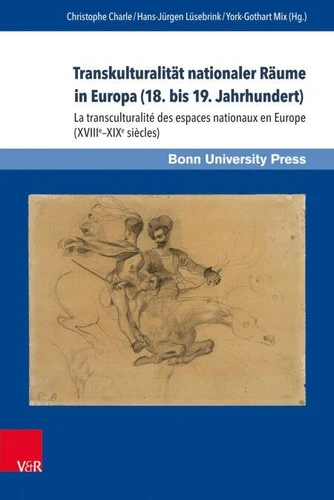Transkulturalität nationaler Räume in Europa (18. bis 19. Jahrhundert). Übersetzungen, Kulturtransfer und Vermittlungsinstanzen. La transculturalité des espaces nationaux en Europe (XVIIIe - XIXe siècles). Traductions, transferts culturels et instances de médiations
Par : , , ,Formats :
Disponible dans votre compte client Decitre ou Furet du Nord dès validation de votre commande. Le format PDF est :
- Compatible avec une lecture sur My Vivlio (smartphone, tablette, ordinateur)
- Compatible avec une lecture sur liseuses Vivlio
- Pour les liseuses autres que Vivlio, vous devez utiliser le logiciel Adobe Digital Edition. Non compatible avec la lecture sur les liseuses Kindle, Remarkable et Sony
 , qui est-ce ?
, qui est-ce ?Notre partenaire de plateforme de lecture numérique où vous retrouverez l'ensemble de vos ebooks gratuitement
Pour en savoir plus sur nos ebooks, consultez notre aide en ligne ici
- Nombre de pages481
- FormatPDF
- ISBN978-3-8470-0479-0
- EAN9783847004790
- Date de parution11/09/2017
- Protection num.pas de protection
- Taille9 Mo
- Infos supplémentairespdf
- ÉditeurV&R Unipress
Résumé
Der Band bietet eine systematische Analyse des Kulturaustauschs und der Übersetzungsprozesse im europäischen Raum von der Mitte des 18. bis Anfang des 20. Jahrhunderts. Die Untersuchung der Zirkulation ausländischer Texte aus den Bereichen Belletristik, Literaturkritik und Theater dokumentiert das Ausmaß des Interesses und die Rezeptionsbereitschaft für ausländische Werke. In Fallstudien wird die Rolle der Akteure des Kulturtransfers herausgestellt - darunter Übersetzer und Kritiker sowie Institutionen der Vermittlung.
Die Erforschung der Austauschbeziehungen hinterfragt die Formen, die Intensität und die Auswirkungen der kulturellen Internationalisierung in einer Periode zunehmender Nationalisierung und legt somit den Grundstein für eine europäische, transkulturelle Kulturgeschichte. This volume provides a systematic analysis of the cultural exchange and translation processes within the European area from the middle of the 18th through to the beginning of the 20th Century.
The study of the circulation of foreign texts from the fields of fiction, literary criticism and theatre documents both the extent of people's interest in and receptiveness to foreign works. Case studies highlight the role of those who contributed to cultural transfer, including translators, critics and mediation institutions. The exploration of these exchange relationships questions the forms, the intensity and the effects of cultural internationalisation during a period of increasing nationalisation and thus lays the foundations for European transcultural cultural history.
Die Erforschung der Austauschbeziehungen hinterfragt die Formen, die Intensität und die Auswirkungen der kulturellen Internationalisierung in einer Periode zunehmender Nationalisierung und legt somit den Grundstein für eine europäische, transkulturelle Kulturgeschichte. This volume provides a systematic analysis of the cultural exchange and translation processes within the European area from the middle of the 18th through to the beginning of the 20th Century.
The study of the circulation of foreign texts from the fields of fiction, literary criticism and theatre documents both the extent of people's interest in and receptiveness to foreign works. Case studies highlight the role of those who contributed to cultural transfer, including translators, critics and mediation institutions. The exploration of these exchange relationships questions the forms, the intensity and the effects of cultural internationalisation during a period of increasing nationalisation and thus lays the foundations for European transcultural cultural history.
Der Band bietet eine systematische Analyse des Kulturaustauschs und der Übersetzungsprozesse im europäischen Raum von der Mitte des 18. bis Anfang des 20. Jahrhunderts. Die Untersuchung der Zirkulation ausländischer Texte aus den Bereichen Belletristik, Literaturkritik und Theater dokumentiert das Ausmaß des Interesses und die Rezeptionsbereitschaft für ausländische Werke. In Fallstudien wird die Rolle der Akteure des Kulturtransfers herausgestellt - darunter Übersetzer und Kritiker sowie Institutionen der Vermittlung.
Die Erforschung der Austauschbeziehungen hinterfragt die Formen, die Intensität und die Auswirkungen der kulturellen Internationalisierung in einer Periode zunehmender Nationalisierung und legt somit den Grundstein für eine europäische, transkulturelle Kulturgeschichte. This volume provides a systematic analysis of the cultural exchange and translation processes within the European area from the middle of the 18th through to the beginning of the 20th Century.
The study of the circulation of foreign texts from the fields of fiction, literary criticism and theatre documents both the extent of people's interest in and receptiveness to foreign works. Case studies highlight the role of those who contributed to cultural transfer, including translators, critics and mediation institutions. The exploration of these exchange relationships questions the forms, the intensity and the effects of cultural internationalisation during a period of increasing nationalisation and thus lays the foundations for European transcultural cultural history.
Die Erforschung der Austauschbeziehungen hinterfragt die Formen, die Intensität und die Auswirkungen der kulturellen Internationalisierung in einer Periode zunehmender Nationalisierung und legt somit den Grundstein für eine europäische, transkulturelle Kulturgeschichte. This volume provides a systematic analysis of the cultural exchange and translation processes within the European area from the middle of the 18th through to the beginning of the 20th Century.
The study of the circulation of foreign texts from the fields of fiction, literary criticism and theatre documents both the extent of people's interest in and receptiveness to foreign works. Case studies highlight the role of those who contributed to cultural transfer, including translators, critics and mediation institutions. The exploration of these exchange relationships questions the forms, the intensity and the effects of cultural internationalisation during a period of increasing nationalisation and thus lays the foundations for European transcultural cultural history.



